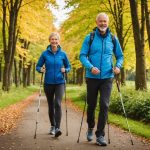Unlocking Strength: How High-Protein Diets Combat Sarcopenia in Seniors
As we age, our bodies undergo a series of natural changes that can impact our health and quality of life. One of the most significant challenges faced by older adults is sarcopenia, the loss of muscle mass and strength that can lead to frailty, disability, and a reduced quality of life. However, recent research and practical strategies suggest that high-protein diets can play a crucial role in combating this age-related condition.
Understanding Sarcopenia
Sarcopenia is a progressive loss of skeletal muscle mass and strength that occurs as we age. It is a natural part of the aging process, but it can be accelerated by factors such as physical inactivity, poor nutrition, and certain medical conditions.
Topic to read : Exploring the Impact of Platelet-Rich Plasma Therapy on Healing Chronic Tendon Injuries
The Impact on Health
Sarcopenia is not just a matter of aesthetics; it has significant implications for the health and well-being of older adults. Here are some key points to consider:
- Muscle Weakness: The loss of muscle mass and strength can make everyday activities more challenging, increasing the risk of falls and injuries[4].
- Reduced Mobility: Sarcopenia can limit mobility, making it harder for older adults to maintain their independence and engage in activities they enjoy.
- Metabolic Changes: Muscle tissue plays a crucial role in metabolism. As muscle mass decreases, metabolic rate can slow down, contributing to weight gain and other health issues.
- Quality of Life: Sarcopenia can significantly impact the quality of life, leading to decreased physical function, reduced social interaction, and increased dependency on others.
The Role of Protein in Combating Sarcopenia
Protein is a fundamental nutrient for muscle health, and its importance becomes even more critical as we age.
In the same genre : Unlocking Serenity: The Transformative Power of Mind-Body Practices for Chronic Stress Relief
Protein Intake and Muscle Health
Higher protein intakes have been shown to help prevent age-related sarcopenia. Here’s why:
- Protein Synthesis: Protein is essential for muscle protein synthesis, the process by which the body builds and repairs muscle tissue. Adequate protein intake ensures that this process is optimized, helping to maintain or even increase muscle mass[4].
- Amino Acids: Protein is composed of amino acids, which are the building blocks of muscle tissue. Essential amino acids (EAAs), in particular, are crucial for stimulating muscle protein synthesis.
- Resistance Training: When combined with resistance training, high-protein diets can enhance muscle strength and mass. This is because resistance exercises stimulate muscle protein synthesis, and adequate protein intake provides the necessary amino acids to support this process.
Practical Strategies for High-Protein Diets
Implementing a high-protein diet is not just about consuming more protein; it involves a thoughtful approach to nutrition and lifestyle.
Recommended Protein Intake
The recommended daily intake of protein varies, but for older adults, higher intakes are often recommended:
- General Recommendations: The Recommended Dietary Allowance (RDA) for protein is about 0.8 grams per kilogram of body weight per day. However, many scholars suggest that older adults may benefit from higher intakes, up to 1.2-1.6 grams per kilogram of body weight per day[4].
- Timing of Protein Intake: It is also important to consider the timing of protein intake. Consuming protein after exercise, particularly resistance training, can help maximize muscle protein synthesis.
Foods High in Protein
Here are some high-protein foods that can be easily incorporated into a senior’s diet:
- Lean Meats: Chicken, turkey, and lean beef are excellent sources of protein.
- Fish: Fish like salmon and tuna are not only high in protein but also rich in omega-3 fatty acids.
- Eggs: Eggs are a versatile and high-protein food.
- Dairy: Milk, yogurt, and cheese are good sources of protein.
- Plant-Based Options: Legumes, beans, lentils, and tofu are excellent plant-based protein sources.
- Supplements: For those who struggle to get enough protein from whole foods, protein supplements like whey protein can be beneficial. Products like Whey Native from Nutrimuscle, which is derived directly from fresh milk without chemical treatments, can be particularly effective[1][2].
Combining Diet with Exercise
While diet is crucial, it is equally important to combine a high-protein diet with regular exercise to combat sarcopenia effectively.
Resistance Training
Resistance training is a key component of any anti-sarcopenia strategy:
- Benefits: Resistance exercises help build muscle mass and strength, improve bone density, and enhance overall physical function.
- Examples: Weightlifting, resistance band exercises, and bodyweight exercises like push-ups and squats are all effective.
- Frequency and Intensity: Aim for at least two sessions of resistance training per week, targeting all major muscle groups.
Other Forms of Exercise
In addition to resistance training, other forms of exercise can also be beneficial:
- Cardiovascular Exercise: Activities like walking, cycling, or swimming can help improve cardiovascular health and overall fitness.
- Flexibility and Balance Exercises: Exercises like yoga or tai chi can improve flexibility and balance, reducing the risk of falls.
Case Studies and Success Stories
Real-life examples can provide inspiration and practical insights into how high-protein diets and exercise can combat sarcopenia.
Example: Mrs. Johnson’s Journey
Mrs. Johnson, a 75-year-old retired teacher, noticed a significant decline in her physical strength and mobility over the past few years. After consulting with her healthcare provider, she started a high-protein diet and incorporated resistance training into her weekly routine. Within six months, she reported improved muscle strength, better mobility, and an overall enhancement in her quality of life.
Table: Comparing Protein Sources
Here is a comparative table of different protein sources, highlighting their protein content and other relevant nutritional information:
| Protein Source | Protein Content (per serving) | Other Nutrients |
|---|---|---|
| Chicken Breast | 30-35 grams (3 oz serving) | Low in fat, rich in vitamins B6 and niacin |
| Salmon | 20-25 grams (3 oz serving) | Rich in omega-3 fatty acids, vitamin D |
| Eggs | 6-7 grams (large egg) | Rich in vitamins D and B12, choline |
| Greek Yogurt | 20 grams (6 oz serving) | Rich in calcium, probiotics |
| Whey Protein | 20-25 grams (scoop) | Rich in EAAs, low in fat and lactose[1][2] |
| Lentils | 18 grams (1 cup cooked) | Rich in fiber, iron, potassium |
Tips for Implementation
Here are some practical tips for implementing a high-protein diet and exercise plan to combat sarcopenia:
- Consult a Healthcare Provider: Before starting any new diet or exercise program, it is essential to consult with a healthcare provider to ensure it is safe and appropriate.
- Start Slow: Gradually increase protein intake and the intensity of exercise to avoid overexertion.
- Stay Hydrated: Adequate hydration is crucial for overall health and muscle function.
- Monitor Progress: Regularly monitor muscle mass, strength, and overall health to adjust the diet and exercise plan as needed.
Combating sarcopenia requires a multifaceted approach that includes a high-protein diet, regular exercise, and a commitment to overall health and wellness. By understanding the role of protein in muscle health, incorporating high-protein foods and supplements into the diet, and engaging in resistance training and other forms of exercise, older adults can significantly reduce the impact of sarcopenia and maintain their strength, mobility, and quality of life.
As Dr. Stuart Phillips, a renowned scholar in the field of muscle health, notes, “Higher protein intakes may help prevent age-related sarcopenia, the loss of muscle mass, and strength that predisposes older adults to frailty, disability, and reduced quality of life”[4].
By taking proactive steps to address sarcopenia, older adults can unlock their strength and vitality, ensuring a healthier and more fulfilling life as they age.










